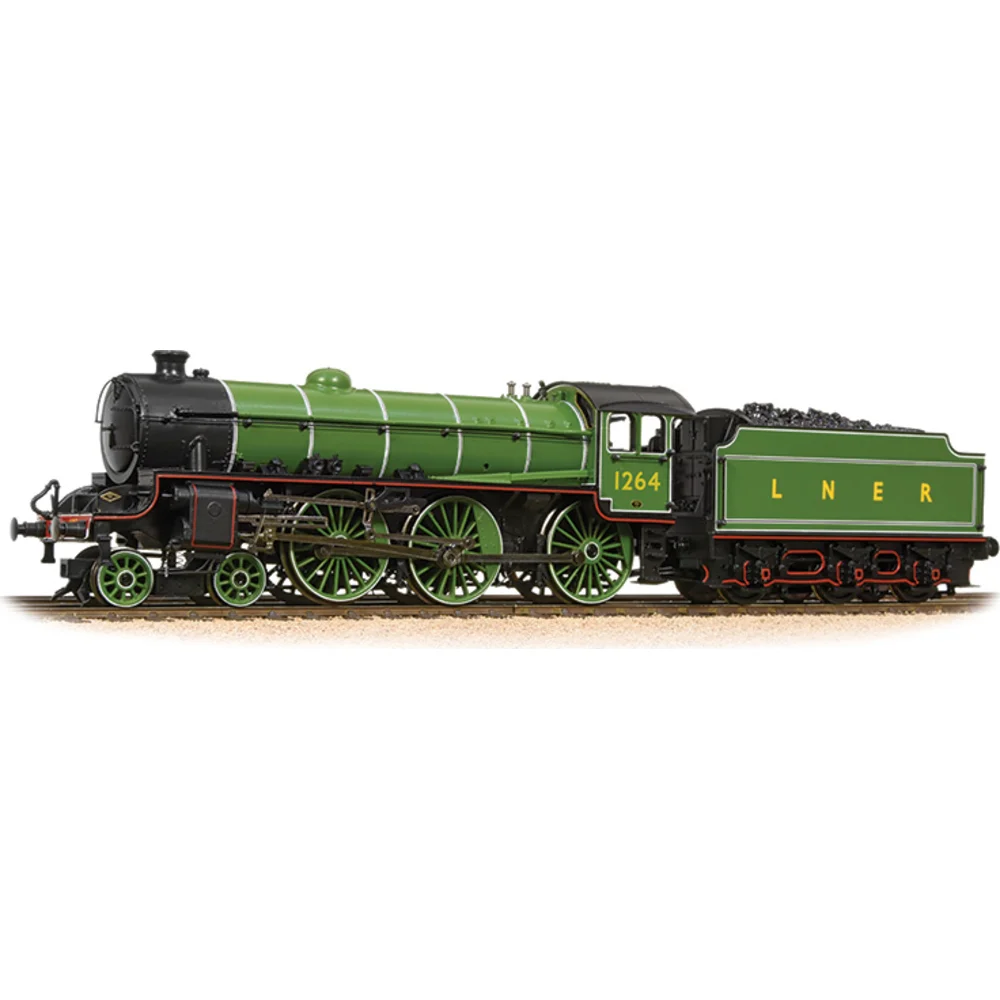Bachmann 31-717
London & North Eastern Railway B1 1264 London & North Eastern Railway Lined Apple Green
Tooling
In 2011, Bachmann announced a major upgrade to its long-standing LNER B1 tooling, originally inherited from Replica Railways. This revision addressed criticisms of the earlier split-chassis design and brought the model up to modern standards. The upgrade focused on improved running qualities, DCC compatibility, and enhanced detailing, while retaining the overall body profile of the previous tooling. It was part of a broader program that also modernized Bachmann’s A4 and V2 models.
Tooling Features
- Scale: OO gauge (1:76).
- Construction: Plastic bodyshell with separately fitted details; chassis combines plastic and metal for strength and weight.
- Detailing: Factory-fitted handrails, pipework, safety valves, whistles, and bufferbeam detail. Sprung buffers and chemically blackened wheels add realism. Cab glazing included; cab interior detail improved compared to earlier versions.
- Couplings: NEM pockets with tension-lock couplers.
Mechanical & Electrical
- Motor & Drive: Smooth-running can motor with loco-drive mechanism; all-wheel pickup for reliable performance.
- Minimum Radius: Designed for second radius curves (approx. 438 mm).
- Lighting: No factory lighting provision.
- Weighting: Metal components within chassis and tender for improved adhesion.
- Power Collection: 2-rail DC.
DCC Capability
- DCC Ready with 8-pin socket located in the locomotive.
- No factory provision for speaker; sound installation requires modification.
Liveries Produced
The upgraded tooling has been released in several authentic schemes, including:
- LNER Apple Green and LNER Lined Black.
- BR Black with early emblem.
- BR Black with late crest (including weathered variants).
Reviews & Commentary
Model Rail and other publications praised the new chassis for near-silent running and excellent slow-speed control, a significant improvement over the older split-frame design. However, some reviewers noted limited haulage capacity with heavy trains. Social media and video reviews highlight the model’s smooth performance and ease of DCC fitting, though the absence of factory sound and lighting options is seen as a drawback. Enthusiasts appreciate the upgrade for reliability and value, even if the body tooling remains less refined than contemporary Hornby equivalents.
Interesting Notes
- The upgrade retained the original Replica Railways body mouldings, focusing investment on mechanical improvements.
- Named locomotives and weathered finishes have featured in special editions.
Class & Prototype
- Class: London & North Eastern Railway B1
- Traction: Steam
- Built: 1942-1952
- Total Built: 410
- Running Number: 1264
Operator & Livery
- Operator: London & North Eastern Railway
- Livery: Lined Apple Green
- Era: 3 - The big 4 – LMS, GWR, LNER & SR
The London & North Eastern Railway emerged in 1923 as Britain's second-largest railway company, combining seven major railways including the Great Northern, North Eastern, and Great Eastern into a 6,590-mile network stretching from London's four terminals to the Scottish Highlands. Despite serving economically challenged industrial regions, the LNER achieved worldwide recognition for engineering excellence and speed records that remain unbroken today.
Under Chief Mechanical Engineers Sir Nigel Gresley, Edward Thompson, and Arthur Peppercorn, the LNER developed revolutionary locomotive designs characterised by three-cylinder layouts and streamlined aesthetics. Gresley's masterpieces included the A1 Pacifics featuring Flying Scotsman and the legendary A4 class, culminating in Mallard's world steam speed record of 126 mph in 1938.
The company pioneered luxury express services including the Silver Jubilee and Coronation streamliners, whilst investing in forward-thinking electrification schemes and massive marshalling yards. Notable achievements included operating the complete East Coast Main Line, introducing Britain's first regular 400-mile non-stop service, and commissioning Eric Gill's iconic typography that influenced railway design for decades.
Nationalised in 1948, LNER locomotives continued serving British Railways until the 1960s, with some A4 Pacifics working Scottish expresses until 1966. Today, the LNER's engineering legacy thrives through extensive preservation, new-build projects like Tornado, and comprehensive model ranges covering every major class in all popular scales, making LNER subjects essential for discerning railway modellers seeking authentic British steam-age atmosphere.
